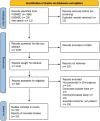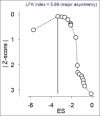Seropositivity of Chikungunya in Hospital Setting, India: A Systematic Review and Meta-Analysis
- PMID: 39668927
- PMCID: PMC11633274
- DOI: 10.4103/ijcm.ijcm_63_24
Seropositivity of Chikungunya in Hospital Setting, India: A Systematic Review and Meta-Analysis
Abstract
Backround: Information about the chikungunya disease burden by age groups and geographic distribution is necessary to guide appropriate control measures. With this, we conducted a systematic review and meta-analysis to estimate the disease burden of chikungunya fever in India.
Material and methods: We conducted this systematic review according to the Cochrane Collaboration guidelines. We retrieved relevant articles from PubMed and a free online search. Two investigators screened titles and abstracts and extracted data from the relevant articles. Our primary outcome is the proportion of laboratory-confirmed Chikungunya fever among clinically suspected patients. We used a random effect model to estimate the pooled proportion of Chikungunya fever.
Result: A total of 20 articles were included in the quantitative syntheses. The pooled proportion of laboratory-confirmed chikungunya fever from 20 studies estimated using the random effects model is 24% (95%CI: 15-34%). We found the pooled proportion in the southern region was 35% (95%CI: 4-66%), 28% (95%CI: 3-58%) in the western region, 24% (95%CI: 1-48%) in the eastern region, 20% (95%CI: 12-29%) in the northern region, and 4% (95%CI: 1-6%) in North-eastern region.
Conclusion: This review emphasizes the need to strengthen the surveillance of disease burden using multiple diagnostic tests and the need for an appropriate molecular diagnostic for early detection of the chikungunya virus.
Keywords: Chikungunya; meta-analysis; proportion; sero-positivity; systematic review.
Copyright: © 2024 Indian Journal of Community Medicine.
Conflict of interest statement
There are no conflicts of interest.
Figures
References
-
- Chikungunya fact sheet. Available from: https://www.who.int/news-room/fact-sheets/detail/chikungunya. [Last accessed on 2022 Jul 21]
-
- Prevention | Chikungunya virus | CDC. 2022. Available from: https://www.cdc.gov/chikungunya/prevention/index.html. [Last accessed on 2022 Jul 21]
-
- Krishnamoorthy K, Harichandrakumar KT, Krishna Kumari A, Das LK. Burden of chikungunya in India: Estimates of disability adjusted life years (DALY) lost in 2006 epidemic. J Vector Borne Dis. 2009;46:26–35. - PubMed
-
- Ravi V. Re-emergence of chikungunya virus in India. Indian J Med Microbiol. 2006;24:83–4. - PubMed
Publication types
LinkOut - more resources
Full Text Sources



